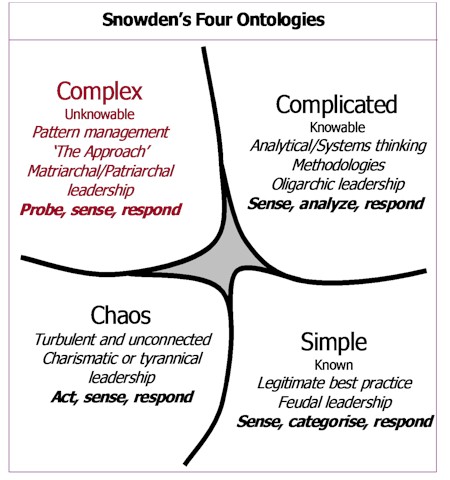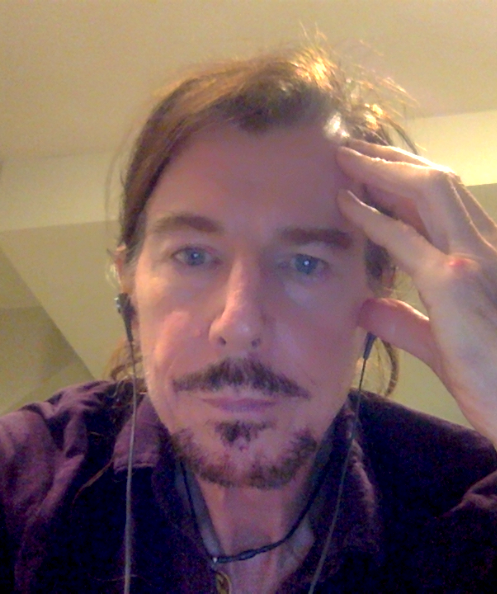 Last week in my article on Design Thinking I mentioned that such thinking is focused on “wicked problems”, which I defined as “the intractable, complex-system challenges that require parallel iterations of both the ‘problem’ and the ‘solution’, until both become clearer at the same time (and sometimes once you find the ‘solution’ you realize your concept of the ‘problem’ was wrong)”. A couple of readers picked up on the term and wanted to know if I had coined it, and more about such problems. The term was coined by Horst Rittel and Melvin Webber in 1973 to describe problems in public policy and planning that defy solution by analytical methods. Wicked problems, they said, have these ten characteristics:
The Cognexus Institute provides these examples of Wicked Problems meeting these criteria:
My list of the world’s ten most intractable problems all meet these criteria as well. The people I have spoken with who deal routinely with such problems have stopped using the terminology that was traditionally applied to complicated but ‘tame’ problems: solution, analysis, cause. They even avoid using the term ‘problem’ because its connotation is something that has a solution. But the terms that are appropriate instead are awkward, because they hit home the impotence of those trying to tackle them: instead of solutions and problems they talk of “approaches to deal with or cope with” a “situation”. And instead of analysis and cause they use complex-system terminology like “pattern recognition” and “correlation”. It’s a humbling vernacular, and it’s not surprising so many have chosen to leave such ‘problems’ for others to ‘solve’, or to use fruitless, complicated-system tame-problem ‘solutions’ that appear to work for awhile, and blame their later failure on other factors. So how should we “deal with” complex situations, when the current state is clearly unsatisfactory and suboptimal? Let’s start by looking at three examples of what nature does in such situations. Dave Snowden has described how birds flying in a flock so gracefully are simply following three ‘simple rules’: they fly towards the centre of the flock, veer to avoid colliding with other birds, and match speed to the neighbouring birds in the flock as much as possible. How do they ‘know’ to do this? Instinct. Second example: Geese follow a number of rules to determine breeding rights and territories. Only one breeding pair is allowed in each (large, well-sheltered) breeding area. Each breeding area is usually maintained unchanged from year to year. Only geese who migrated to the area the previous year are ‘eligible’ to be breeders. Until they are three years old, geese may only ‘play nest’ (the eggs, if laid at all, are not fertilized or incubated). Those who meet these criteria may vie for breeding rights, in a ritual that is usually more noise than fight, and is usually won by the eldest goose and gander which are healthy. The non-breeding geese then migrate further north to all-bachelor summering grounds. The goslings are immediately transfered to an open area (one where predators can be seen coming from far away). Several breeding pairs will meet at this area, and if there are fewer than about four goslings per adult, some of the adults will leave their newborns with the remaining adults and migrate to the northern summering grounds. How does this complex series of behaviours occur with such predictability? In part it in instinctive, and in part it is evolutionary: Trial and error. If one ‘rule’ leads to better survival, the survivors will perpetuate that rule and teach it to the next generation. Third example: In the winter, a certain number of the birds that summered in each area will hibernate, a certain number will migrate to a warmer climate, and a certain number will feed on what’s stored away or available all winter long. Birds rarely freeze to death. Somehow they just know how many should stay, how many should go, and how many should sleep. There is no hierarchy at work here, making the decision. The decision on what to do is made by each individual, and the collective wisdom is right. Now let’s look at human complex situations. Chris Corrigan has been using one complex situation technique, Open Space Technology, very successfully, for a number of years, addressing issues like suicide among First Nations youths. The critical differentiators between this technique and more traditional business techniques are:
There are a number of organizations and journals researching how to cope with complex situations (sometimes called social complexity to differentiate from mathematical complexity). Most of them acknowledge the wisdom of the methods nature uses to deal with complexity, and the value of Open Space Technology. Snowden has developed an interesting model called ABIDE which calls for:
If you put all the principles highlighted in green above together you have what might be the start of a means of coping or dealing with Wicked Problems. Not a system or methodology, mind you — these concepts don’t apply in the brave new complex world — just a means, an approach. Some stuff that seems to work. If you’re a manager, or a consultant, and this seems way too soft and imprecise for comfort, you’ll just have to learn to ‘deal’ with it. If you’re a fan of the approaches of Freakonomics or the Wisdom of Crowds, a complex approach to Wicked Problems is probably right up your alley. |
Navigation
Collapsniks
Albert Bates (US)
Andrew Nikiforuk (CA)
Brutus (US)
Carolyn Baker (US)*
Catherine Ingram (US)
Chris Hedges (US)
Dahr Jamail (US)
Dean Spillane-Walker (US)*
Derrick Jensen (US)
Dougald & Paul (IE/SE)*
Erik Michaels (US)
Gail Tverberg (US)
Guy McPherson (US)
Honest Sorcerer
Janaia & Robin (US)*
Jem Bendell (UK)
Mari Werner
Michael Dowd (US)*
Nate Hagens (US)
Paul Heft (US)*
Post Carbon Inst. (US)
Resilience (US)
Richard Heinberg (US)
Robert Jensen (US)
Roy Scranton (US)
Sam Mitchell (US)
Tim Morgan (UK)
Tim Watkins (UK)
Umair Haque (UK)
William Rees (CA)
XrayMike (AU)
Radical Non-Duality
Tony Parsons
Jim Newman
Tim Cliss
Andreas Müller
Kenneth Madden
Emerson Lim
Nancy Neithercut
Rosemarijn Roes
Frank McCaughey
Clare Cherikoff
Ere Parek, Izzy Cloke, Zabi AmaniEssential Reading
Archive by Category
My Bio, Contact Info, Signature Posts
About the Author (2023)
My Circles
E-mail me
--- My Best 200 Posts, 2003-22 by category, from newest to oldest ---
Collapse Watch:
Hope — On the Balance of Probabilities
The Caste War for the Dregs
Recuperation, Accommodation, Resilience
How Do We Teach the Critical Skills
Collapse Not Apocalypse
Effective Activism
'Making Sense of the World' Reading List
Notes From the Rising Dark
What is Exponential Decay
Collapse: Slowly Then Suddenly
Slouching Towards Bethlehem
Making Sense of Who We Are
What Would Net-Zero Emissions Look Like?
Post Collapse with Michael Dowd (video)
Why Economic Collapse Will Precede Climate Collapse
Being Adaptable: A Reminder List
A Culture of Fear
What Will It Take?
A Future Without Us
Dean Walker Interview (video)
The Mushroom at the End of the World
What Would It Take To Live Sustainably?
The New Political Map (Poster)
Beyond Belief
Complexity and Collapse
Requiem for a Species
Civilization Disease
What a Desolated Earth Looks Like
If We Had a Better Story...
Giving Up on Environmentalism
The Hard Part is Finding People Who Care
Going Vegan
The Dark & Gathering Sameness of the World
The End of Philosophy
A Short History of Progress
The Boiling Frog
Our Culture / Ourselves:
A CoVid-19 Recap
What It Means to be Human
A Culture Built on Wrong Models
Understanding Conservatives
Our Unique Capacity for Hatred
Not Meant to Govern Each Other
The Humanist Trap
Credulous
Amazing What People Get Used To
My Reluctant Misanthropy
The Dawn of Everything
Species Shame
Why Misinformation Doesn't Work
The Lab-Leak Hypothesis
The Right to Die
CoVid-19: Go for Zero
Pollard's Laws
On Caste
The Process of Self-Organization
The Tragic Spread of Misinformation
A Better Way to Work
The Needs of the Moment
Ask Yourself This
What to Believe Now?
Rogue Primate
Conversation & Silence
The Language of Our Eyes
True Story
May I Ask a Question?
Cultural Acedia: When We Can No Longer Care
Useless Advice
Several Short Sentences About Learning
Why I Don't Want to Hear Your Story
A Harvest of Myths
The Qualities of a Great Story
The Trouble With Stories
A Model of Identity & Community
Not Ready to Do What's Needed
A Culture of Dependence
So What's Next
Ten Things to Do When You're Feeling Hopeless
No Use to the World Broken
Living in Another World
Does Language Restrict What We Can Think?
The Value of Conversation Manifesto Nobody Knows Anything
If I Only Had 37 Days
The Only Life We Know
A Long Way Down
No Noble Savages
Figments of Reality
Too Far Ahead
Learning From Nature
The Rogue Animal
How the World Really Works:
Making Sense of Scents
An Age of Wonder
The Truth About Ukraine
Navigating Complexity
The Supply Chain Problem
The Promise of Dialogue
Too Dumb to Take Care of Ourselves
Extinction Capitalism
Homeless
Republicans Slide Into Fascism
All the Things I Was Wrong About
Several Short Sentences About Sharks
How Change Happens
What's the Best Possible Outcome?
The Perpetual Growth Machine
We Make Zero
How Long We've Been Around (graphic)
If You Wanted to Sabotage the Elections
Collective Intelligence & Complexity
Ten Things I Wish I'd Learned Earlier
The Problem With Systems
Against Hope (Video)
The Admission of Necessary Ignorance
Several Short Sentences About Jellyfish
Loren Eiseley, in Verse
A Synopsis of 'Finding the Sweet Spot'
Learning from Indigenous Cultures
The Gift Economy
The Job of the Media
The Wal-Mart Dilemma
The Illusion of the Separate Self, and Free Will:
No Free Will, No Freedom
The Other Side of 'No Me'
This Body Takes Me For a Walk
The Only One Who Really Knew Me
No Free Will — Fightin' Words
The Paradox of the Self
A Radical Non-Duality FAQ
What We Think We Know
Bark Bark Bark Bark Bark Bark Bark
Healing From Ourselves
The Entanglement Hypothesis
Nothing Needs to Happen
Nothing to Say About This
What I Wanted to Believe
A Continuous Reassemblage of Meaning
No Choice But to Misbehave
What's Apparently Happening
A Different Kind of Animal
Happy Now?
This Creature
Did Early Humans Have Selves?
Nothing On Offer Here
Even Simpler and More Hopeless Than That
Glimpses
How Our Bodies Sense the World
Fragments
What Happens in Vagus
We Have No Choice
Never Comfortable in the Skin of Self
Letting Go of the Story of Me
All There Is, Is This
A Theory of No Mind
Creative Works:
Mindful Wanderings (Reflections) (Archive)
A Prayer to No One
Frogs' Hollow (Short Story)
We Do What We Do (Poem)
Negative Assertions (Poem)
Reminder (Short Story)
A Canadian Sorry (Satire)
Under No Illusions (Short Story)
The Ever-Stranger (Poem)
The Fortune Teller (Short Story)
Non-Duality Dude (Play)
Your Self: An Owner's Manual (Satire)
All the Things I Thought I Knew (Short Story)
On the Shoulders of Giants (Short Story)
Improv (Poem)
Calling the Cage Freedom (Short Story)
Rune (Poem)
Only This (Poem)
The Other Extinction (Short Story)
Invisible (Poem)
Disruption (Short Story)
A Thought-Less Experiment (Poem)
Speaking Grosbeak (Short Story)
The Only Way There (Short Story)
The Wild Man (Short Story)
Flywheel (Short Story)
The Opposite of Presence (Satire)
How to Make Love Last (Poem)
The Horses' Bodies (Poem)
Enough (Lament)
Distracted (Short Story)
Worse, Still (Poem)
Conjurer (Satire)
A Conversation (Short Story)
Farewell to Albion (Poem)
My Other Sites





I would also recommend the lessons from Adam Kahane’s book, “Solving Tough Problems”.
I’d second that Harold.
Thanks guys — Kahane is referenced several times in Presence, so I’ve already added this to me ‘to read’ list.
I have posted a dissenting viewpoint on my blog. I am not a manager or a consultant, just a lowly engineer who also happens to be a root cause analyst… and this all does seem to lack the amount of rigor I would usually require (i.e., it is soft and imprecise). My way of ‘dealing’ with it was to write a rebuttal. Comments are welcome.
Here’s a direct link to my rebuttal article:Root Cause Analysis for Complex Systems?